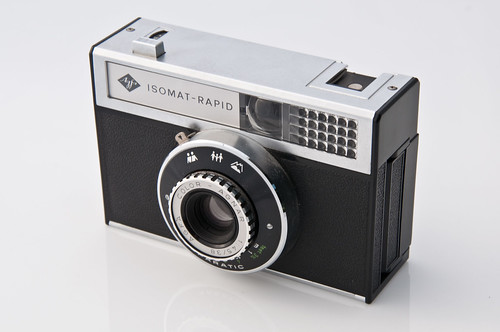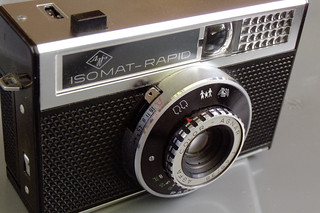Difference between revisions of "Isomat Rapid"
(a few tweaks after spending some time with this model) |
Hanskerensky (talk | contribs) (Added Category:I) |
||
| (8 intermediate revisions by 4 users not shown) | |||
| Line 8: | Line 8: | ||
}} | }} | ||
| − | The 1965 '''Isomat Rapid''' is one of [[Agfa]]'s series of squared-off, largely plastic, "Iso" cameras made for their easy-loading [[Rapid film]] system. | + | The 1965 '''Isomat Rapid''' is one of [[Agfa]]'s series of squared-off, largely plastic, "Iso" cameras made for their easy-loading [[Rapid film]] system. Versions with white or black nameplates are known. |
| − | + | The Isomat Rapid outwardly resembles Agfa's simple fixed-focus Rapid models like the [[Agfa Iso-Rapid I | Iso-Rapid I]]; and like those, it gives 16 square exposures of 24×24 mm per roll. Interlocks only allow the shutter to fire with the back closed and film advancing; and a frame counter behind the shutter release counts down the exposures remaining. (After the 16th exposure, the film advance will turn continuously but the shutter locks.) | |
| − | + | ==Special features== | |
| + | But the Isomat Rapid is a more sophisticated model, with weightier body and a [[guess focus|scale-focusing]], three-element Color-Agnar 38mm f/4.5 lens. The feet/meter distance scale is inconveniently located underneath the lens; instead simple pictograms face upwards towards the user. For two of these, the focusing scale has click-stop detents. The black-faced version of the camera has a "two heads" icon that is strangely chosen: When focused at this distance, the lens's field of view is actually well over a meter/yard high. The white-face camera has a more suitable icon, showing the whole torsos of two people. | ||
| − | + | While one might suspect that the "fly eye" panel beside the viewfinder might be a dummy light meter (as on other cheap snapshot cameras), this is a true [[selenium meter|selenium cell]], which automatically adjusts the diamond-shaped lens [[aperture]] opening as the photographer presses the shutter release. If this aperture is within the available range of f/4.5–16, an indicator dot at the right side of the (not terribly accurate) viewfinder switches from red to green, indicating proper exposure. The camera has a fixed shutter speed, nominally 1/70th second, in autoexposure mode. | |
| − | The Isomat Rapid takes advantage of one advanced feature of the [[Rapid film]] standard, namely its emulsion-speed index tab. | + | For flash exposure using the included [[hot shoe]], a tab on the side of the lens permits manual selection of apertures. When using these settings, the shutter speed switches to approximately 1/30th of a second, to accommodate the burning time of bulb flashes. |
| + | |||
| + | ==Speed indexing== | ||
| + | <div class="floatleft plainlinks" style="margin:0px 25px 15px 0px;"> | ||
| + | {{Flickr_image | ||
| + | |image_source= http://www.flickr.com/photos/camerawiki/5898216893/in/pool-camerawiki | ||
| + | |image= http://farm6.static.flickr.com/5269/5898216893_1504a0da65_n.jpg | ||
| + | |image_align= left | ||
| + | |image_text= Black-nameplate version | ||
| + | |image_by= Voxphoto | ||
| + | |image_rights= nc | ||
| + | }} | ||
| + | </div> | ||
| + | {{br}} | ||
| + | The Isomat Rapid takes advantage of one advanced feature of the [[Rapid film]] standard, namely its emulsion-speed index tab. Whenever a photographer purchased a fresh roll of Agfa Rapid film, it would come loaded into a cassette with a tab encoding the appropriate [[film speed]]. This allowed a suitably-equipped Rapid camera to adjust its meter readings accordingly. The indexing key is a silver metal plate affixed to the side of the cassette, whose central tab is shorter for slow films and longer for fast ones. (Empty cassettes of any speed could be used in the film take-up compartment. Rapid rolls had the emulsion type punched into the loose tail of the film to remind the photographer which kind had just been shot.) | ||
| + | |||
| + | Rapid loads were standard perforated 35mm film, so today's photographer does not find it too daunting to reload empty Rapid cassettes in a darkroom; but the speed-index system does create the extra headache of locating (or modifying) cassettes for the correct tab length. | ||
| − | |||
==Links== | ==Links== | ||
*[http://www.butkus.org/chinon/agfa/agfa_isomat_rapid/agfa_isomat_rapid.htm Multi-lingual manual] at Mike Butkus' [http://www.butkus.org/chinon/ OrphanCameras.com] | *[http://www.butkus.org/chinon/agfa/agfa_isomat_rapid/agfa_isomat_rapid.htm Multi-lingual manual] at Mike Butkus' [http://www.butkus.org/chinon/ OrphanCameras.com] | ||
| − | *[http://www.collection-appareils.fr/ | + | *[http://www.collection-appareils.fr/x/html/page_standard.php?id_appareil=92 Isomat Rapid] at [http://www.collection-appareils.fr/general/html/francais.php Sylvain Halgand's www.collection-appareils.fr] (in French) |
| + | |||
[[Category: Rapid film]] | [[Category: Rapid film]] | ||
[[Category: Agfa|Isomat Rapid]] | [[Category: Agfa|Isomat Rapid]] | ||
| + | [[Category:I|Isomat Rapid Agfa]] | ||
[[Category: German viewfinder]] | [[Category: German viewfinder]] | ||
Latest revision as of 05:21, 27 July 2022

|
| Agfa Isomat-Rapid (1965 -1969) image by Hans Jan Dürr (Image rights) |
The 1965 Isomat Rapid is one of Agfa's series of squared-off, largely plastic, "Iso" cameras made for their easy-loading Rapid film system. Versions with white or black nameplates are known.
The Isomat Rapid outwardly resembles Agfa's simple fixed-focus Rapid models like the Iso-Rapid I; and like those, it gives 16 square exposures of 24×24 mm per roll. Interlocks only allow the shutter to fire with the back closed and film advancing; and a frame counter behind the shutter release counts down the exposures remaining. (After the 16th exposure, the film advance will turn continuously but the shutter locks.)
Special features
But the Isomat Rapid is a more sophisticated model, with weightier body and a scale-focusing, three-element Color-Agnar 38mm f/4.5 lens. The feet/meter distance scale is inconveniently located underneath the lens; instead simple pictograms face upwards towards the user. For two of these, the focusing scale has click-stop detents. The black-faced version of the camera has a "two heads" icon that is strangely chosen: When focused at this distance, the lens's field of view is actually well over a meter/yard high. The white-face camera has a more suitable icon, showing the whole torsos of two people.
While one might suspect that the "fly eye" panel beside the viewfinder might be a dummy light meter (as on other cheap snapshot cameras), this is a true selenium cell, which automatically adjusts the diamond-shaped lens aperture opening as the photographer presses the shutter release. If this aperture is within the available range of f/4.5–16, an indicator dot at the right side of the (not terribly accurate) viewfinder switches from red to green, indicating proper exposure. The camera has a fixed shutter speed, nominally 1/70th second, in autoexposure mode.
For flash exposure using the included hot shoe, a tab on the side of the lens permits manual selection of apertures. When using these settings, the shutter speed switches to approximately 1/30th of a second, to accommodate the burning time of bulb flashes.
Speed indexing

|
| Black-nameplate version image by Voxphoto (Image rights) |
The Isomat Rapid takes advantage of one advanced feature of the Rapid film standard, namely its emulsion-speed index tab. Whenever a photographer purchased a fresh roll of Agfa Rapid film, it would come loaded into a cassette with a tab encoding the appropriate film speed. This allowed a suitably-equipped Rapid camera to adjust its meter readings accordingly. The indexing key is a silver metal plate affixed to the side of the cassette, whose central tab is shorter for slow films and longer for fast ones. (Empty cassettes of any speed could be used in the film take-up compartment. Rapid rolls had the emulsion type punched into the loose tail of the film to remind the photographer which kind had just been shot.)
Rapid loads were standard perforated 35mm film, so today's photographer does not find it too daunting to reload empty Rapid cassettes in a darkroom; but the speed-index system does create the extra headache of locating (or modifying) cassettes for the correct tab length.
Links
- Multi-lingual manual at Mike Butkus' OrphanCameras.com
- Isomat Rapid at Sylvain Halgand's www.collection-appareils.fr (in French)